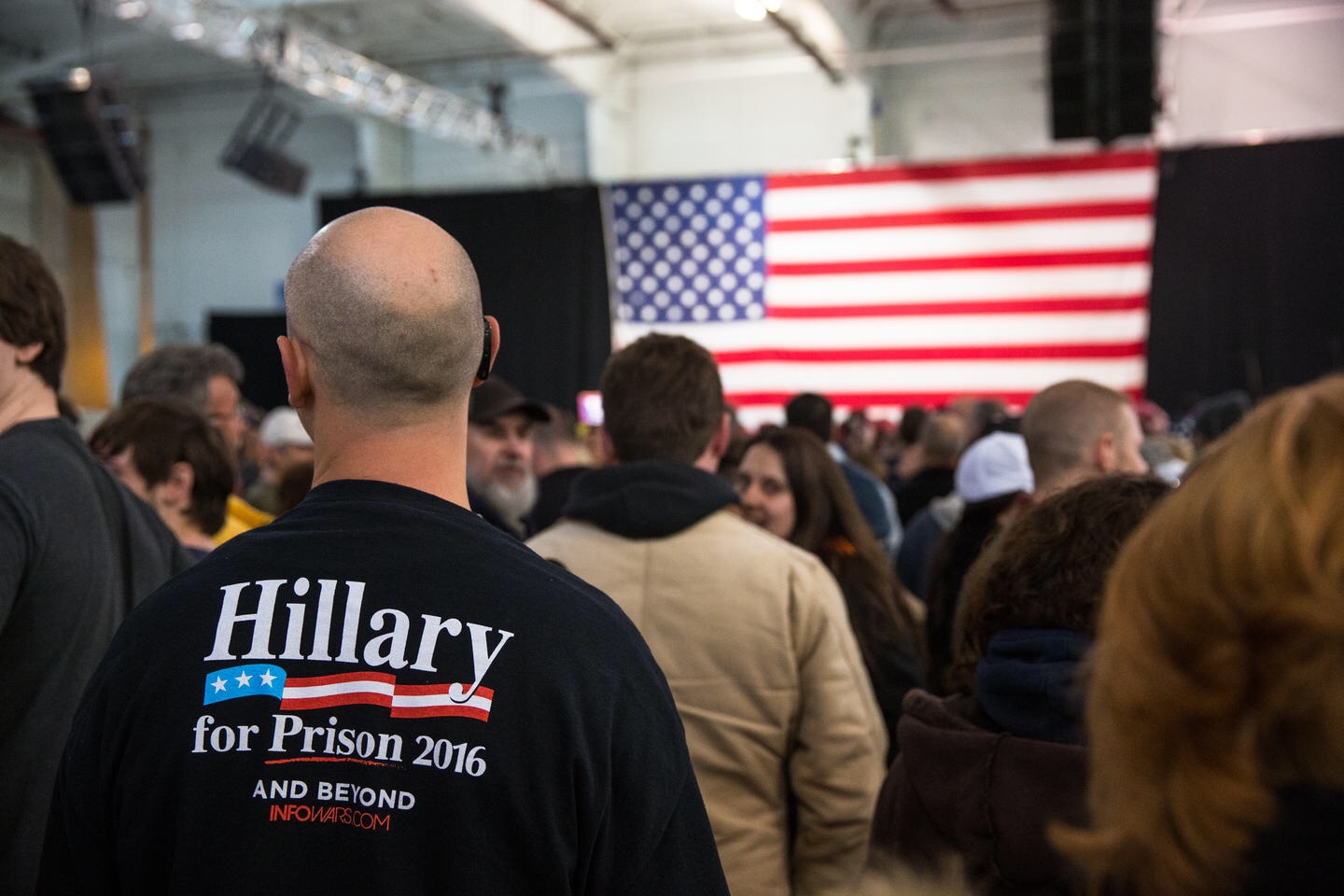We’re now in a post-Kavanaugh world, and it’s a tense one. Democrats have lost trust in the Supreme Court (which seems a natural, if delayed, reaction to Republicans deliberately destroying the judicial confirmation process). Establishment Democrats like Hillary Clinton are finally calling for Democrats to stop being “civil” and start fighting back.
Of course, right-wing media is now misrepresenting her comments as, literally, “a declaration of war and a license for violence“. This deliberate lie is meant to prime Trump supporters for a pogrom against liberals, possibly liberal women in particular. (Not that they need much more priming; the Trump crowd’s chants of “lock her up” have now expanded beyond Hillary Clinton to include Sen. Feinstein, too.)
This is how fascism becomes violent; it falsely blames the victims for initiating or provoking the violence. By the time violence erupts, the public is primed to accept it. This false narrative of violence could exist for just one reason:
To build a case for war.
Incivility versus incitement
The “declaration of war” lie comes from New York Post columnist and regular Fox News contributor Michael Goodwin, who just a few days ago accused Hillary Clinton of promoting “a whirlwind of fanatical hate, with violence now routinely threatened and sometimes carried out.” In yesterday’s followup, he provided Clinton’s comments and his own commentary:
“You cannot be civil with a political party that wants to destroy what you stand for, what you care about,” Clinton told CNN. “That’s why I believe, if we are fortunate enough to win back the House and/or the Senate, that’s when civility can start again. But until then, the only thing that the Republicans seem to recognize and respect is strength.”
There you have it — a declaration of war and a license for violence. Where is the media outrage?
Where is the declaration of war in her statement? Where is the license for violence?
To be clear, given the name of this site, I wouldn’t personally object to someone taking out a number fascists by force. But my current goal is to document fascism, including lies and propaganda designed to make your opponent seem violent. And there is a huge gap between calls for less civility (what Clinton said) and calls for more violence (how Goodwin construed it).
Goodwin does seem to understand that “fighting” language in politics doesn’t mean actual violence. Later in the same column, he describes Trump as “fighting” the Democrats, clearly meaning politically. But this, too, reinforces the greater lie that Democrats started this “fight” by claiming the GOP is merely “fighting back”:
[I]f the Kavanaugh experience revealed anything, it is that Trump’s GOP knows how to fight back and win.
This is blatant bullshit. The GOP picked this fight when they thwarted President Obama’s right to appoint federal judges and justices. Even then, the GOP was blatantly lying and accusing the Democrats of “court-packing” just by trying to fill open seats. They falsely claimed their destruction of the judicial confirmation process was provoked, like they’re claiming to be provoked towards violence now.
This idea of gaslighting America and blaming Democrats for their own seizure of power is not new. This is Republicans building a cassus belli, a “case for war” against their political opponents. The lie builds the foundation for Trump and his supporters to claim, when the time comes, that any violence against liberals / Democrats is justified.
But Clinton obviously wasn’t inciting violence at all. By falsely claiming she was, they’re starting to prime people for violent reprisals.
Pogroms, reprisals, and repetition
Americans being more familiar with Nazism than other forms of fascism, I assume many have heard of Kristallnacht. While perhaps the most well-known to Americans, it’s just one of many “pogroms” against Jews across European history. These pogroms were typically framed as a reprisal or response to some Jewish transgression. And they didn’t occur in a vacuum.
Joseph Goebbels, in particular, was busy priming Germans for violence against Jews for years. In a 1927 essay titled “Why Do We Oppose the Jews?“, for example, Goebbels wrote:
We oppose the Jews because we are defenders of the freedom of the German people. The Jew is the cause and beneficiary of our slavery. He has misused the social misery of the broad masses to deepen the cursed divisions between right and left in our people, to split Germany in half. This was the real reason that we lost the Great War on the one hand, and for the corruption of the revolution on the other.
That was 12 years before Kristallnacht. It takes time to prime the public this way, to convince them they are so threatened by a group of people that violent responses are appropriate. You cannot simply move the crowd from peace to bloodthirst. You must move them slowly, gradually, until they become ready to accept the violence as their own idea, as part of their beliefs and identify. This was something Goebbels understood particularly well:
The purpose of Nazi propaganda was not to brainwash ordinary Germans, and it was not intended to deceive the masses even though it did enable the movement to gain new recruits. The principal objective, according to historian Neil Gregor, was “to absorb the individual into a mass of like-minded people, and the purpose of the ‘suggestion’ was not to deceive but to articulate that which the crowd already believed.”
The essence of the Nazi propaganda method was repetition. Goebbels argued that the skill of British propagandists during the Great War resided in the fact that they used just a few powerful slogans and kept repeating them.
The power of slogans and repetition to motivate is nothing new. As mentioned above, in 1914 the British created a poster with simple art and a few slogans, that (together with its U.S. and Russian derivatives) was perhaps the single most successful propaganda poster of all time.
But the British war propaganda wasn’t deceitful, or provocative of internal conflict against their own people. That was Goebbels’ addition to the formula. The British used such propaganda to recruit volunteers to fight the German threat abroad; Goebbels used such propaganda to recruit civilians to embrace pogroms against local Jews.
The virus is mutating
The problem with the psychology of repetition is that its effects are both unavoidable and self-sustaining. Just like other slogans, lies repeated over time become familiar and believable, even in the face of evidence to the contrary. Trump’s recent lie that Brett Kavanaugh was “proven innocent” will be repeated by Trump until it’s just accepted and repeated by others. Like Taylor Swift songs, overplayed slogans get stuck in your head, whether you want them there or not.
Slogans are viral, which means a concise, well-crafted lie can turn deadly. It also means that death can spread quickly once it mutates. After more than a decade of Goebbels’ anti-Jewish propaganda, anti-Jewish violence exploded across Germany in 1938 in a single day.
We’re becoming on the verge of this. The simplest, most obvious lie of this sort is from Trump’s 2016 campaign, and not even originally from Trump himself. As Trump denounced Clinton on the campaign trail, his audiences began chanting “lock her up” seemingly on their own. These chants were heard inside the Republican National Convention and at Trump-Pence 2016 tour rallies.
Trump originally avoided responding in kind, for weeks. Then, in October and during a debate, Trump bluntly told Clinton that if he was President, “You’d be in jail.” Two days later, at another rally, he embraced and legitimized the crowd’s demand with, “Yeah, ‘lock her up’ is right!“
With the midterms approaching, and Trump heavily on the campaign trail again, “lock her up” is back. Now it’s targeting not just Clinton but Feinstein too. The virus is mutating, all on its own. How many other liberal women will be targeted by “lock her up” next?
You lock up criminals. You lock up dangers to society. That’s what this chant is doing, it’s branding liberal women, outspoken women, as dangerous.
Against that backdrop, of a simple three-word chant indicating the crowd’s condemnation of Clinton and Feinstein as criminals, the New York Post opinion piece should be terrifying. The “crimes” Clinton is accused of so far (something something Benghazi something emails) are not violent or dangerous crimes warranting a deadly force response. But now the right-wing propaganda machine is accusing Clinton of inciting violence against Trump supporters. This alone could transform “lock her up” from a mere accusation of wrongdoing to a literal battle cry.
To be clear, it’s okay to observe that the nation is divided, or even that it feels like we’re on a path to civil war, as Thomas Friedman wrote last week. Moral coward Jeff Flake complained neutrally last week that “tribalism is ruining us.” But that’s not what Michael Goodwin did. He wrote that Clinton is declaring war and encouraging violence. That’s a blatant lie, a simple lie, and a lie that could be used to justify a violent response.
It’s not hard to see where this is going, or at least where it could go, from here. They’re starting to build a case for war.

